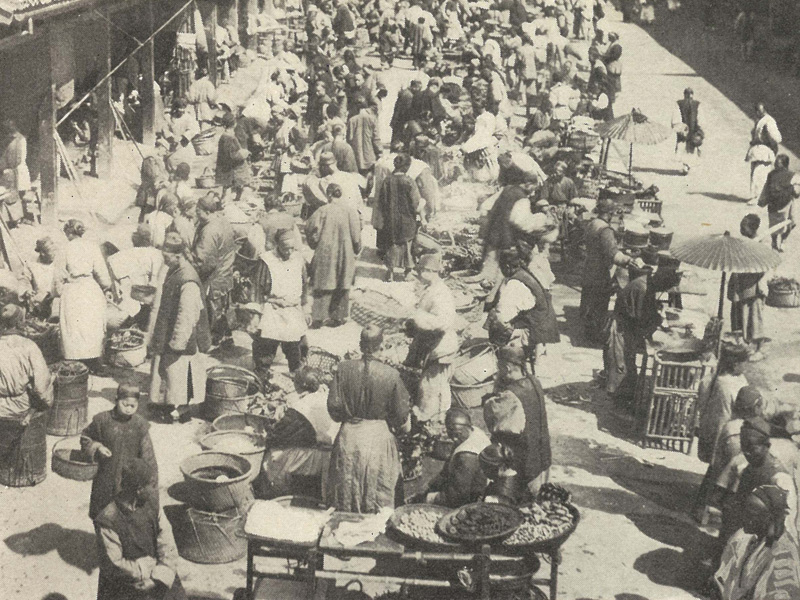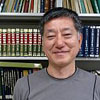
Periodic market in Shandong Province at the end of the 19th century.
Arthur H. Smith, Village life in China: A Study in Sociology. New York: Fleming H. Revell, 1899.
Let us consider for a moment a three-way stand-off. For example, a farmer possesses rice, but he requires a hoe. A blacksmith possesses a hoe, but requires charcoal. A lumberjack possesses charcoal, but requires rice. As the situation currently stands no-one among these three people can get the commodity he requires. However, the blacksmith can give a hoe to the farmer and in return receive rice that he doesn't want, but then can acquire charcoal from the lumberjack by providing him with the rice that he requires. By transferring their own products to another person, each one of the farmer, blacksmith and lumberjack is able to acquire something that they want. In the case of the rice, the moment the blacksmith-who does not require the rice itself-takes receipt of it, it is expected to function not as something to be consumed, but as something to be transferred to a third party. By exchanging assets that are readily transferrable, regardless of individual need or requirement, everyone's needs are fulfilled. In this example rice functions as money.
The above example represents the logical framework that has been maintained and further refined from the 19th century up to the present day as an explanation for how money came into use. The advantage of this framework is that it is capable of explaining the existence of paper currencies that are in general circulation today and which are not convertible into precious metals, by making the negotiability function of assets stand independently of their original function. Although the concept of government-designated currency being accepted precisely because it is guaranteed by political powers is a deep-rooted one, the emergence of endogenous currencies arising from commerce and trade is grounded in logic that is unaffected by such exogenous factors.
Currency is considered to facilitate the exchange of goods, but it could also be deemed to be the starting point for speculative activities, which emerge from discrepancies in the exchange between the goods and services people produce and the goods and services they require. It seems entirely natural and plausible to consider that the origins of trade and commerce are based on the fact that "Commerce will not take place between two doctors, but will arise between a doctor and a farmer" (The Nicomachean Ethics, Aristotle). Although it is appealing to see the birth of currency through the three-way stand-off described above, where discrepancies in goods produced and goods required result in the creation of currency by bringing in a third-party to the transaction, the framework concerning the origins of the act of exchange has been adhered to since the time of Aristotle. The framework for speculation shows itself to be deep-rooted and wide-spread in various aspects. The argument of the economic anthropologist Karl Polanyi, for example, that money is not needed among farmers, is an extension of this framework. But is it truly the case that farmers do not engage in exchange with each other and they have no need for money to be used in transactions between themselves?
According to studies of the traditional markets that have been held on such regular intervals as every five days in every region of the world throughout history, it is certainly the case that merchants and other vendors brought goods from other areas to sell at market, but in actual fact the majority of the people who would gather at the market to buy and sell goods would be farmers living within a half-day's journey of the market. Accordingly, the majority of goods exchanged at these periodic markets would be goods brought by these farmers and which they had grown or produced themselves. While it was the case that farmers would bring to market whatever they thought they might be able to sell, the great majority of the products sold were everyday items such as cereal crops and hand-made cloth. This demonstrates that the farmers were mainly engaging in exchange of products that they had themselves produced, which is in contradiction to the three-way transaction described above. In extreme terms you could perceive a bizarre situation in which a farmer who produces rice also becomes a purchaser of rice. However, on closer examination, this is not such an outlandish idea. This is because out of all the farmers gathered at the market who were engaged in the production of rice, there would be times when some had a surplus and when others were lacking rice due to a poor harvest.
These markets were places where a large, but not infinite, number of farmers would gather. Let us say, for the sake of argument, a total of 2,000 farmers came to market. While the farmers would possibly become familiar with a number of other farmers through repeated visits to the market, the scale of the market would be sufficient enough to ensure a degree of anonymity. Let us also assume that there are people at the market who share a rule of thumb that there will be times after the harvest when rice is in abundance. If farmer A has a rice surplus, he will exchange rice for some sort of asset belonging to farmer B, who has a rice shortage. Even if farmer A has no need for the asset he has received, it is possible that in the future when farmer A himself is short of rice, farmer C or farmer D at the market may exchange that unneeded asset for rice. If the unneeded asset that is exchangeable for rice comes to be specified (let us say the asset is pen), then in that particular market that asset becomes the currency. In actual fact these kinds of localized currency have appeared throughout the centuries, in all regions and cultures.
Whether it be a pen or scraps of paper, what it is that the farmers are exchanging by using these unwanted assets is "surplus time" and "future or past surplus time." This is not a case of borrowing and lending between farmer A who has a surplus and farmer B who has a shortage. There is the potential for farmer A to acquire rice from anyone among the 2,000 farmers at the market.
In all traditional societies throughout history the most numerous members of society were farmers, but the exchanges that occurred between fellow farmers have been largely overlooked. At the instant that the concept that "there can be no trade between two doctors" became accepted, "time" became an abstract concept in the framework, and although the concept of there not being exchange between the same types of industry may appear logical, it is in actual fact very far from reality. It is in this way that for more than 2,000 years money theory has been discussed based on principles of the division of labor that are essentially free of any concept of time and gloss over the real accomplishments of the majority of humankind. What has been necessary these past two millennia is not to think of money solely in terms of a relationship between people in certain trades, be they doctors or farmers, but rather to think in terms of a concept that incorporates changes over time, such as the changing seasons.




